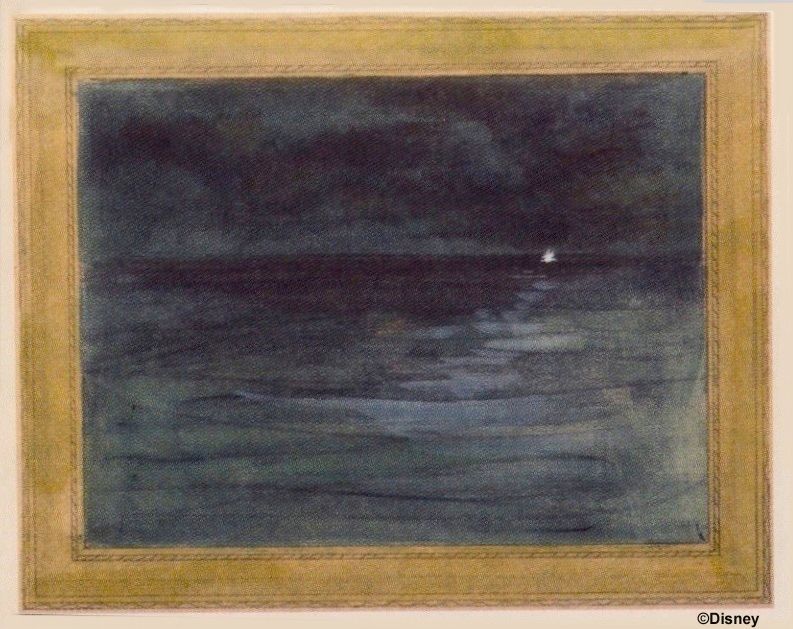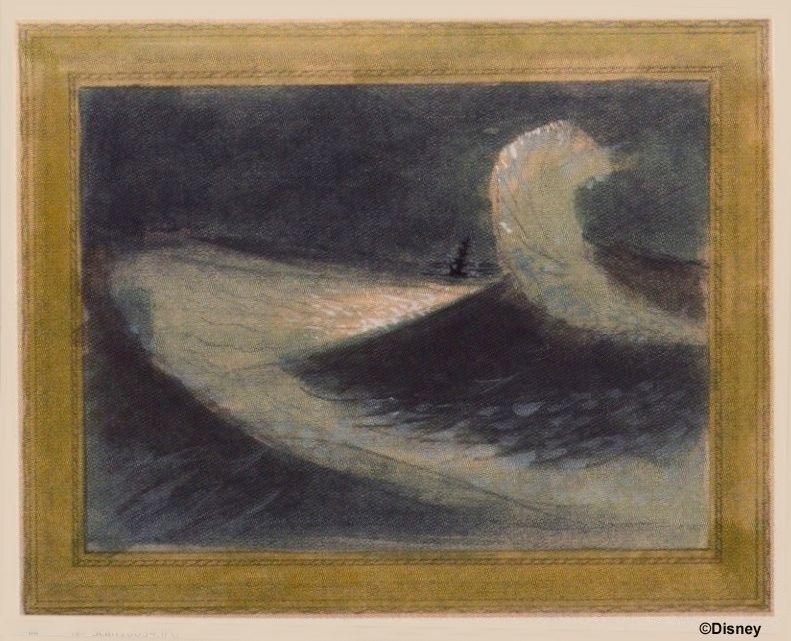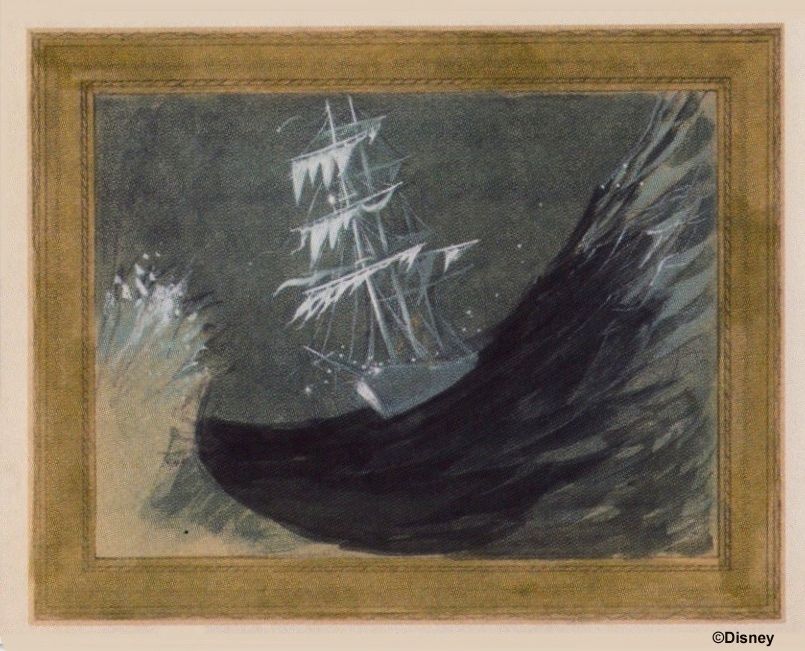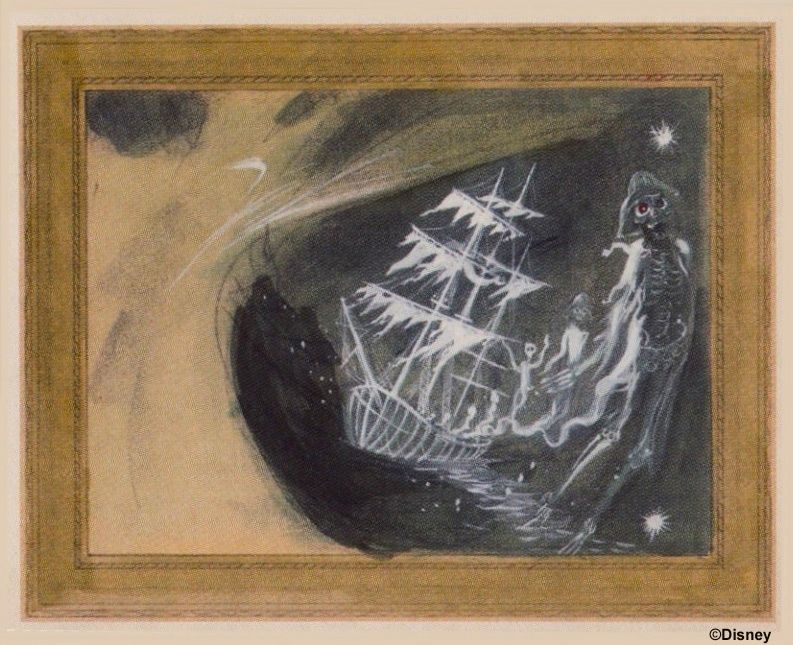For you seasoned Mansionites, this post starts out with stuff everyone knows, proceeds to stuff a lot of people know, goes from there to something not too many people know, and ends up with thoughts that no mortal has ever thunk before. Ever.
So don't bail early.
(Not only that, but dig on the spectacular new artwork discovered only in October of 2015!)
The Flying Dutchman painting in the changing portrait hallway has remained constant in both its appearance and its position from the Haunted Mansion blueprints down to the present hour. Not that it hasn't had a turbulent history. Like all five of the paintings, it originally changed back and forth with a lightning flash effect, but sometime within the first few years, the paintings went to a slow morphing effect, reportedly because it was found that the lightning effect could trigger fits for people with epilepsy. It stayed like that until January of 2005, when the new, higher tech versions were installed. The current lightning effect is a throwback to the original presentation.
Marc Davis, as usual, was responsible for the artwork, although his own paintings only served as guides for other artists who painted the actual showpieces. The effect itself, as usual, was extremely simple: two slides in a special two-slide projector pointing at the same screen from behind. Because they were slides, it was possible to put them in backwards by mistake, and this happened surprisingly often, to judge by the number of photos I've seen in which one or more of the five images is reversed.
Davis never cared for the finished product. This was another compromise made necessary by the speed with which people would go by. Many, if not all, of the Davis changing portraits depicted a whole series of changes (as many as six), that had to be trimmed back to just two. What's missing from the Flying Dutchman (and that is the official name) is, of course, the Flying Dutchman. It's supposed to be the ghost ship seen by sailors before they meet their watery doom.
. "Lars, we are so screwed."
The FD was another one of the famous ghosts that required no introduction to the average viewer and could be employed in a gag that could be read in an instant. What we've got instead is a normal ship getting shredded by a storm. Davis originally conceived of a ghost ship approaching from a distance in a four-panel series dated to 1964.
You can also see the ghosts-coming-out-of-the-ship gag in a miniature
painting found in one of his Portrait Hall concept sketches:
This eventually evolved into a six-part series:
I like Davis's depiction of the electrical phenomenon known as St. Elmo's fire as part of the mix. One of the
Dutchman's eyes, in fact, is a ball of St. Elmo's fire, and his fingers are lightning. Great imagination, eh?
The current incarnation of the Flying Dutchman is not very different from the one it replaced.
It's too bad all this great concept art never made it into the finished product. Such a waste. But maybe not entirely a waste. Is it possible that Davis's Flying Dutchman was an influence on the design of Davy Jones in Pirates of the Caribbean: Dead Man's Chest? As always, dear reader, you can decide that one for yourself. I give it a solid maybe.












Wow - great research! That is true - that Marc was very unhappy with the final speed that the projections were shown at. He told me that when they were projected as originally conceived, very slowly, that they were much more effective. Of course, Marc was not happy with the final version of the Mansion, even though most of us tend to think of it as a classic. When I asked him why he felt this way, he replied, " It was a case of too many cooks!" I don't agree - but he did prefer to do all the design himself - and there are many, many other WED pioneers that deserve commensurate credit (Coats, Crump, Wathel, Joerger, Anderson, Atencio, Gibson, Gracey, etc...).
ReplyDeleteI imagine that Davis would have felt the presence of too many (other) cooks with particular sensitivity in the case of the HM, since the recent experience of the POTC was undoubtedly fresh in his mind, and that project seems to have been closer to the kind of one-man show he preferred (so long as he was that one man, of course). POTC strikes me as a Marc Davis show from start to finish. It certainly did not have the long, checkered history and the competition between various master concepts that the HM had.
ReplyDeleteOh, thank you for finally solving the mystery of the flipped paintings for me. I've got some photos from the mid 90s that I could never figure out why they were reversed from all the other photos I've seen...
ReplyDeleteWere the paintings ever configured to where they would change instantly with the lightning, and then slowly fade back to their original look? Sort of like a reverse fade?
No, it has always been either/or, the lightning or the gradual fade, never a mix.
ReplyDeleteIs there a way to contact the site owner about these pics? There'e great.
ReplyDeleteOne easy way is to join the Micechat boards and then leave a private message for fellow board member "HBG2."
ReplyDeleteThank you for mentioning the old lightning flash effect. It's an effect I very much enjoyed and still prefer to the gentle transformations, because its brevity made you question yourself, "Did I really see that?..." and you never really got a gooood look at the detail of the haunted versions. Catching only a glimpse of fear tends to incite deeper panic (fear of the unknown). Plus, the unexpected suddenness of the effect, conjoined with the lightning flash, served up a kind of "pop-up ghost" foreshadowing. I'd love to see the effect returned. Perhaps with today's tech, there's some way to achieve similar results without endangering epileptics.
ReplyDeleteBy the way, I happened upon your fantastic blog via http://boingboing.net/2013/06/01/coloring-the-haunted-mansion.html -- so thanks: I've now been perusing the LF blog from its inception. It's not like I have any actual work to do or anything. Ahem.
- FanOfWalt
Really interesting stuff. I managed to luck into one of the ghost ship lenticulars from the 1999 30th anniversary event, and was searching for some background information (data on that particular event is surprisingly scarce). Happened upon this posting, and WOW--it really fills in some holes. It appears that they used several of those stages in the ghost ship lenticular, changed others, and added in some extras (there are around 18 stages of movement). The lightning is oddly missing, and it seems to use the blue--rather than the white--version of the last stage (with fully-formed ghosts).
ReplyDeleteI know Marc Davis passed away in 2000, and I have to wonder if he had any input with regards to the creation of that particular lenticular. The work is so obviously his--otherwise I'd have to say some other artists did a fantastic job copying his original concept artwork.
The Flying Dutchman painting is one of my favorite elements within the Haunted Mansion. I never knew about the additional plates Davis had imagined and drawn until reading this post and really wish they had made it to the actual attraction (but understand why they cut it back to only two panels). Wonder if there's any chance Disneyland will ever sell lenticular post cards of the famous "changing" hallway paintings? Would LOVE to have them.
ReplyDelete-SoCalUW